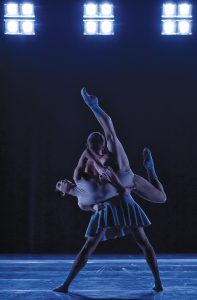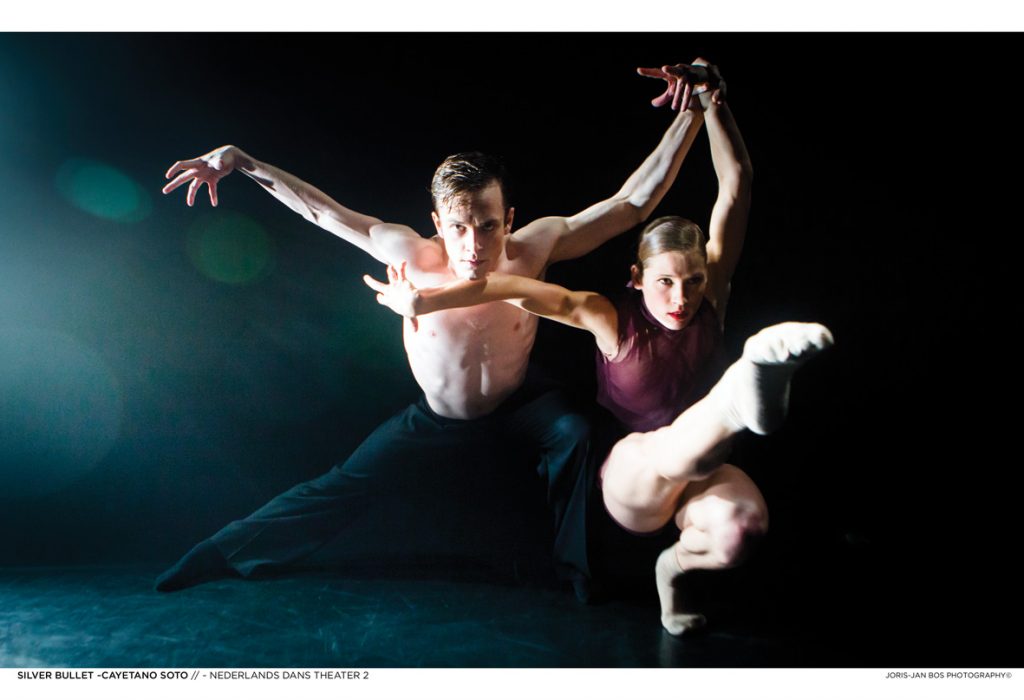From Doubt to Dance: Cayetano Soto’s creative process - Vancouver Ballet Society
- Home
- Features 2015 - 2019
- From Doubt to Dance: Cayetano Soto’s creative process

by Hilary Maxwell
Seven men stand in a line at the ready. The music is cued, and from his chair at the front of the studio, choreographer Cayetano Soto leans in and directs his gaze toward the dancers. The energy shifts swiftly from focused stillness to an exhilarating surge of power as the men launch in unison into a sequence of sculptural movements with sharp changes of direction, their limbs and torsos carving through the space. It’s a week into Ballet BC’s rehearsals for the remount of the Spanish choreographer’s Twenty Eight Thousand Waves. Originally a commission for Ballet BC in 2014, this piece marks the beginning of Soto’s relationship with the Vancouver-based company. In 2015, he was invited to take on the role of resident choreographer for a three-year commitment. Creating ballets was always the plan for Soto. “I never wanted to be a dancer. I wanted to be a choreographer my whole life. I only wanted to learn to dance to know how to use my tool, my body,” he says, referring to his very physical involvement in his own choreographic process.
Soto began his formal dance education at the Institut del Teatre in his hometown of Barcelona, and went on to study at the Royal Conservatoire of The Haag, in Netherlands. He danced for one season at IT Dansa in Barcelona and then joined Ballet Theatre Munich, where he stayed from 1998 to 2005. It was here that Soto created his first ballet, Plenilunio, as part of a workshop performance that showcased pieces created by company dancers. Philip Taylor, who was the artistic director at the time, added Plenilunio into the company’s repertoire, and each year until Soto left he commissioned a new ballet from him.
After three years of balancing his roles as dancer and choreographer, Soto retired from the stage and turned his focus solely toward a career as a freelance choreographer. Today, the 41-year-old is considered a driving force in the contemporary ballet world. His works are in the repertoires of major companies in Europe and North and South America, including Stuttgart Ballet, Royal Ballet of Flanders, Nederlands Dans Theater, Balé da Cidade de São Paulo, Northwest Pacific Dance Project, Aspen Sante Fe Ballet, Les Ballet Jazz de Montréal and Ballet BC. When sourcing inspiration for a new work, Soto doesn’t have to look far. “I don’t get inspired anymore by a painting or a piece of music,” he asserts. “It comes from some internal point of doubt. Some people go to the psychologist. I go to the studio. It’s where I psychoanalyze myself.”
The ideas for his choreographies emerge from personal reflection, struggle and questions he has about life at that moment. Ballet is his vehicle to confront these musings. While his work draws from his private thoughts and “internal life,” he believes they address universal issues that are relatable to everyone on one level or another. When one ballet ends, it leads him directly to the next, conceptually and physically, in a continual linking pattern.

Before beginning Twenty Eight Thousand Waves, Soto had just finished Silver Bullet, an ensemble piece set on Nederlands Dans Theater 2, the junior division of the main company. Choreographing Silver Bullet was Soto’s way of facing emotional demons that had haunted him for many years. “I was carrying a lot of skeletons in my closet with many Cayetanos inside,” he says. The title Silver Bullet came to him because in mythology it is considered a weapon that can effectively kill demons or monsters.
During the transition between the two ballets came a lot of emotion. “You have to be very strong to close one door and open a new one,” says Soto. He uses the image of an oilrig in the middle of the ocean being hit over and over by waves as a way to illustrate how he felt during this transitional process, and to emphasize the strength required to not succumb to the influences that pull at us. From that image the heart of Twenty Eight Thousand Waves started to form.
During the process of creation, Ballet BC’s artistic director Emily Molnar felt there was a unique connection forming between Soto and her company. The synergy between Soto and the dancers in the studio, with the production team and then with the audience, she says, all play into why she saw him as an ideal partner. She hopes that audiences will feel “a certain kind of pride” watching the company and Soto evolve together over three years and feel part of the process.
As a freelancer, teaming up with one company in a long-term engagement is a serious commitment, and Ballet BC is a relatively small group on Canada’s West Coast. “I always say there are no big or small companies. There are companies with ambition and companies without,” Soto says.
And Molnar has big ambition with a bold and innovative direction that appeals to him. Also, he has been given carte blanche in terms of artistic freedom, a gift for any creator. An ongoing role also means that as Soto gets to know the dancers, he can go deeper into the process with them and build on a creative exchange of ideas.
At the start of any creation, Soto has many parts of the piece already mapped out in his mind, including the structure, specific moments and images, costumes and lighting design, all with the music in place. He works very photographically in this way. But once he’s inside the studio, Soto choreographs from a place of “raw instinct.”
He develops movement first by drawing on vocabulary from the previous ballet he made and then, working closely with the dancers, improvises on the movement to expand on and create a new physical language. He attributes intuition as one of the greatest strengths in this process, believing that “when you work from intuition, it takes away from doubt. It’s like this in my work and life.”
When he’s choreographing in the studio, Soto develops material and makes movement choices quickly, responding to an inner impulse informed by this gut feeling. It’s not until afterward, once he’s left rehearsal, that his analytical side kicks in. At night he reflects on the day’s work with a critical lens, trying to uncover the hidden moments or missing pieces within the ballet. Working day and night, Soto hardly sleeps when he’s in the midst of creation.

Both subtle and assertive, Soto’s choreographies require technical aptitude, imagination and abandon. His dance vocabulary is distinct, comprised of nuanced detail and grotesque adaptations of traditional movements. Expressive hands and fingers, and complex, acrobatic duets, are characteristic. In rehearsal, Soto could almost be mistaken as a member of the company, reaching, spiralling and pitching his body through space as he demonstrates the energy and precision he’s after. While the dancers rehearse, he instructs them to “Keep it contained!” referring to the explosive energy his movement embodies, which balances on the edge of combustion. He uses descriptive language, imagery and metaphor to provide entry points into the artistic layers of the choreography.
Rarely does Soto set counts to the movement because, he says, “my emotions do not have numbers.” Instead, he expresses his internal rhythm by vocalizing a medley of sounds and uses his breath to help the dancers access the dynamics and qualities of the phrasing he wants. Sometimes, he will even have the dancers sing the rhythms of the choreography with him.
Alexis Fletcher, who is in her 11th season with Ballet BC, comments on how Soto stresses the importance of finding the energetic and emotional range of the movement. “The body must be so extreme because life forces are so extreme. He told us once that we must emphasize each part as a mirror for the inner forces,” she says.
The next few years for Soto are busy. In addition to his residency with Ballet BC, he has several commissions and remounts for companies in the United States, South America and Europe, including a full-evening work with Augsburg Ballet set to premiere in Germany this May. Wrapping up the season in June, Soto returns to Jacob’s Pillow Dance Festival, opening the event with a brand-new work commissioned by Aspen Santa Fe Ballet.
Undoubtedly, through his future projects, we will continue to see Soto’s inner dialogue transform onstage in artistic extremes. To the same degree, Soto hopes his work will elicit extreme emotional responses from his audiences. “I want people to love it or hate it — to have a reaction. I want them to feel moved.”

